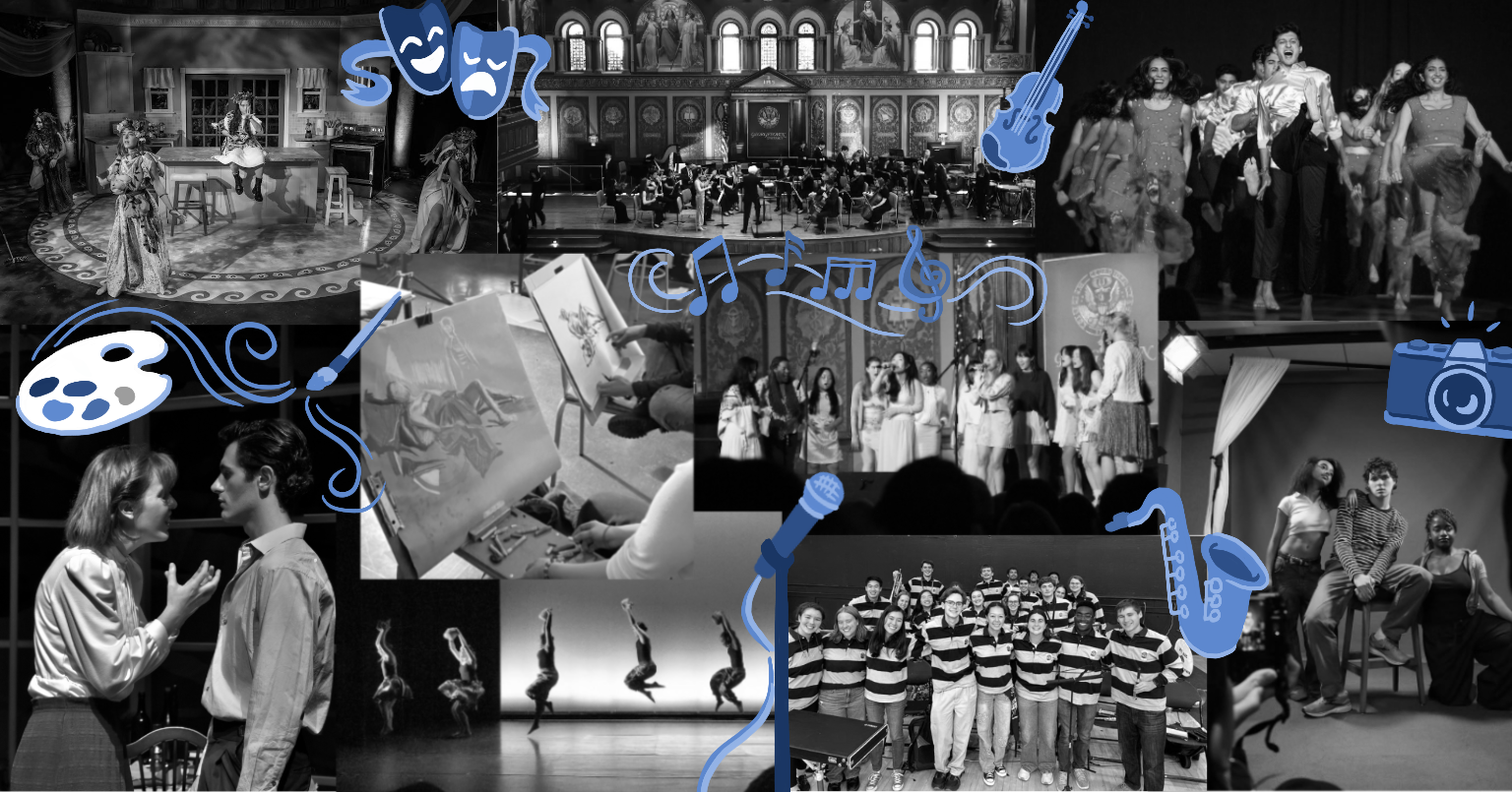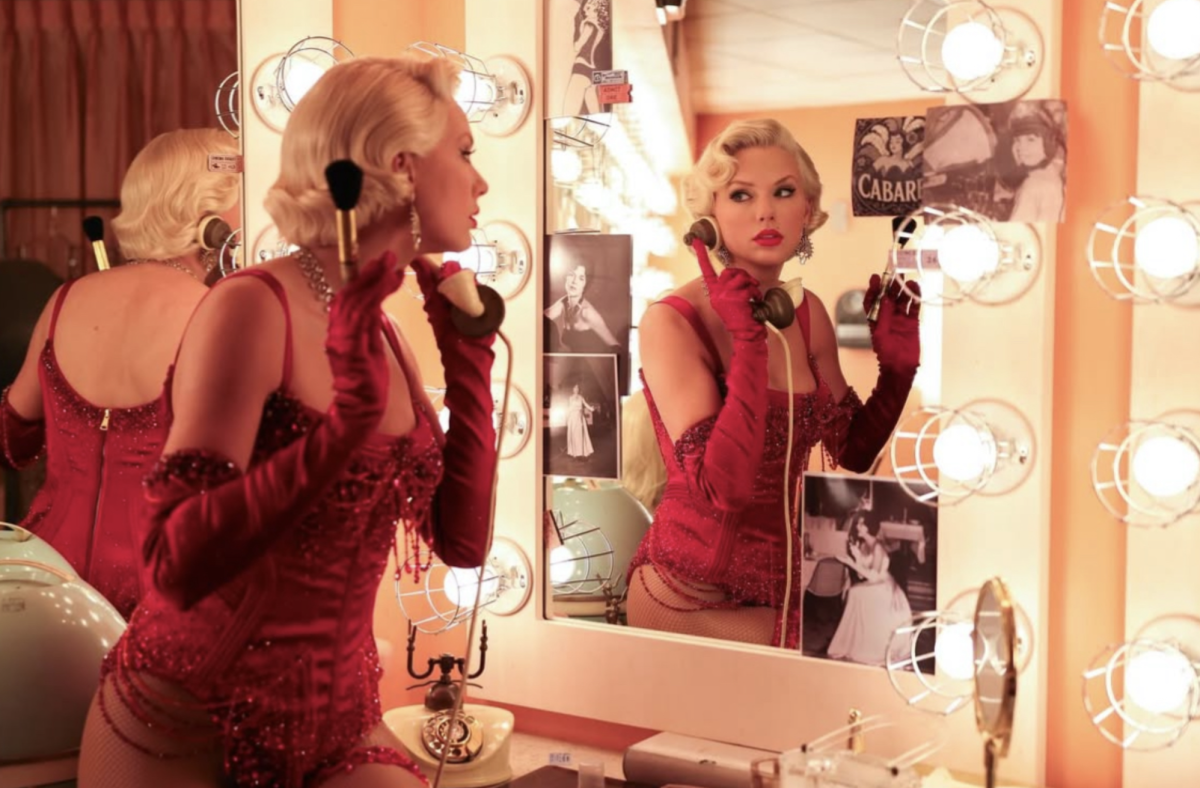As a senior deciding between colleges, Brigid O’Connor (CAS ’26) considered each school’s arts program as a key factor in her final decision. A longtime multi-disciplinary artist, O’Connor wanted a rigorous arts education to develop her skills and maximize space for creative expression.
O’Connor said she initially had reservations about committing to Georgetown University because arts appeared to take a backseat to the university’s more prominent offerings, like government.
“I was worried about the arts program, so I tried like hell to track somebody down to talk to,” O’Connor told The Hoya. “It was actually such an experience of just finding someone who would talk to me in the department.”
Ultimately, O’Connor connected with late Professor John Morrell in the department of art and art history, who convinced her to attend Georgetown by touting the department’s range of curricular programming, faculty expertise and research opportunities.
Georgetown has made meaningful improvements in supporting the arts in the past few decades. However, according to 37 students and faculty members interviewed by The Hoya, Georgetown still lacks the multi-level support — faculty numbers, visibility and well-maintained facilities — needed to flourish.
O’Connor said her experience in the department as a studio art major has been mixed due to noticeable resource deficiencies, causing her to question her initial decision.
“I think if I had known the full picture when I was making the choice, I probably wouldn’t have chosen Georgetown,” O’Connor said. “This is just not at all what I was expecting.”
O’Connor said she appreciates the department’s efforts to still provide students with a comprehensive arts education despite structural limitations.
“They just don’t have the resources to be able to do as much as they would want to do,” O’Connor said.
Beyond academic programming, students have also expressed concerns for university support in arts-based student life.
Georgetown houses numerous student-run arts organizations, including dance troupes, literary publications, music ensembles and theater groups. Many are formal clubs, but students have also collaborated independently of the university, such as by forming bands to perform live gigs.
Isabel Liu (CAS ’27), who plays keys for That Girl Band, a four-member rock ensemble, said one of the ways in which underfunding manifests for student musicians is the lack of sufficient space on campus for rehearsals.
“When you’re practicing for these events, for these gigs, it’s hard to find the available spaces or the resources to do that,” Liu told The Hoya. “A lot of people that I know on campus that do creative stuff have had to make do with what resources we have.”
Full Disclosure: Isabel Liu served as a Senior Science Editor of The Hoya in Spring 2025.
Liu, who is also the executive director of Added to the File, a student-run fashion photography magazine, said the publication had a similar experience.
“I was trying to check out clothes and accessories from the costume shop because we’ve been doing that for the last two years,” Liu said. “We’re not allowed to do that anymore starting this year, and the reason that they gave me was because the costume shop has had severe cuts in their budget, where they don’t have enough people, they don’t have enough student staff.”
A university spokesperson said Georgetown has made concerted efforts to expand support for the arts, including efforts to work with students and hire new faculty and staff.
“The university is grateful to the departmental leadership and faculty for their ongoing work and commitment to Georgetown’s mission,” the spokesperson wrote to The Hoya.
In the Classroom
As part of its curricular offerings, the university supports two departments that are dedicated to the arts: the department of art and art history and the department of performing arts. It also houses a collection of other program-level options for students, who can minor in creative writing, film and media studies or journalism.
Al Acres, a professor in the art and art history department, said his department has faced various challenges.
“When I came to Georgetown in 2006, I didn’t join the department of art and art history — it didn’t exist — I joined the department of art, music and theater,” Acres told The Hoya. “That meant that the way I thought of it, and I think the way a lot of people thought of it, the arts were kind of all bundled conveniently off to the side. It always seemed to me like it was a side dish to what was understood as the real education at Georgetown.”
Acres said he has witnessed the university’s support for the arts develop during his two decades as a professor.
“I’m optimistic — in a word, encouraged,” Acres said.
Acres pointed to the construction of the Davis Center for Performing Arts, which helped create two new specialized departments — art and art history and performing arts — from the original department. The Maria & Alberto de la Cruz and the Lucille M. & Richard F.X. Spagnuolo art galleries also opened in 2018, and the master’s program in art and museum studies started in 2006.
Acres said there are still pressing needs, such as hiring more full-time faculty.
“The proportion of adjuncts in this department is unusually high at the university,” Acres said. “It’s a tremendous strength to have that kind of pool of talent, excellent people, but at any university, it is better for everything if there are more full-time faculty for the consistency of the curriculum that can be offered, the predictability of certain kinds of courses always being available and being connected to active faculty research.”
Currently, 63 percent of the art and art history department faculty are adjuncts and 57 percent of the performing arts department faculty are adjuncts. In contrast, 18 percent of the history department, 29 percent of the math department and 35 percent of the economics department faculty are adjuncts.
Lisa Strong, director of the art and museum studies program, said the size of and funding allocated to Georgetown’s arts department are not comparable to those of other universities.
“Universities of the size of Georgetown, with their own art museums and galleries, tend to fund their programs at a higher level than Georgetown is,” Strong told The Hoya.
Duke University, for example, houses 28 full-track faculty in its department of art, art history and visual studies in comparison to Georgetown’s 10 tenure-track faculty in its department of art and art history. A few blocks away, George Washington University supports 48 full-time faculty in its Corcoran School of Arts and Design.
Michelle Wang, a professor of art history, said the reliance on adjunct faculty creates uncertainty for the department.
“It’s a very tough position to be in, because it means that adjunct faculty aren’t assured teaching from semester to semester,” Wang told The Hoya. “The lack of certainty is very challenging for those faculty who teach on an adjunct basis and also for students to whom we want to assure continuity in courses.”
Judy Wang (CAS ’27), a studio art major, said she has felt a similar lack of certainty when trying to enroll in upper-level classes.
“After I took Painting II, I was going to take Painting III, and I was informed by the department chair that there’s no longer Painting III because they’re restructuring,” Wang told The Hoya. “Now, if you go on the fall course registration, there’s no other painting classes besides Painting I, there’s not even Painting II anymore.”
On the personnel front, Benjamin Harbert, chair of the performing arts department, said the department should hire younger academics at the cutting edge of their sub-fields.
“Our greatest need is in faculty and bringing tenure-line faculty,” Harbert told The Hoya. “We have a lot of full professors here, and we’re starting to get a few younger people, but it would be amazing to have younger faculty who have their own new takes on what’s happening in scholarship, on what’s happening in the arts.”
For students who do take these classes, they cannot always rely on the university to provide arts equipment, creating a high barrier to entry for the arts.
Judy Wang said she spends hundreds of dollars per semester on supplies such as paints and canvases.
“That’s a very large cost burden for people who might be interested in doing a major or minor to even enter into that discipline,” Wang told The Hoya.
Peter Fanone (COL ’15), an adjunct lecturer in the performing arts department, said his colleagues have been resilient in finding ways to make things work despite these funding challenges.
“Georgetown has always been a little engine that could in the department of performing arts,” Fanone told The Hoya. “You wouldn’t expect it.”
Fanone said, however, that expanding investment will enable more students to explore their artistic sensibilities and help the university flourish creatively.
“I want every freshman to know their way around the Davis Center from the moment that they step on campus,” Fanone said. “The more resources that we have, the more that we are able to do and to impact the community.”
Student-Driven Arts Scene
Outside the classroom, students have faced similar challenges in accessing arts resources.
Mason Hall (MSB ’26), president of Georgetown Pep Band, said the ensemble has been struggling to meet demand for instruments as more students express interest in joining.
“Something we definitely would love, and we definitely need, is more school-owned instruments,” Hall told The Hoya. “We almost had to turn a clarinet away because we weren’t sure if we had a clarinet that actually worked for them.”
“It’s the Pep Band’s mission to be open to everybody who can play an instrument,” Hall added. “And we’re definitely trying to make sure everybody who wants to contribute to Georgetown culture in that way is able to.”
Camille Jean (MSB ’27) — director of Black Movements Dance Theatre, a student dance company that performs in a variety of styles including ballet, jazz and hip hop — said the scarcity of resources has disrupted their operations.
“We lost a lot of funding recently — we’ve always been slightly cutting down more and more, but this year, it’s where it’s actually noticeable,” Jean told The Hoya. “Choreographers usually charge way more money than what we’re giving them. The choreographers that we have are just very nice and do it for the love of the game, but we’re basically giving them pennies for the type of work that they’re doing.”
Catherine Patterson (CAS ’27), a member of the Gracenotes, said the all-female and gender minority a cappella group has also been coping with another round of budget cuts.
“The Gracenotes have a much smaller budget this year than we had last year, and that budget was much smaller than it had been my freshman year,” Patterson told The Hoya. “It just feels like we’re constantly fighting to just be seen or to be appreciated.”
Patterson said she feels the university underpublicizes arts events compared to other campus activities.
“There’s no advertising for art on this campus, there’s no momentum behind it,” Patterson told The Hoya. “All of the advertising for artistic events on campus is entirely student-led, whereas things like sports events, networking events, speakers — all of that is really heavily advertised but also really heavily subsidized by the school.”
While the university does not regularly advertise arts events, it does spotlight student arts groups and programming during campus-wide events such as Homecoming and Georgetown Day.
CC Mesa (SFS ’26), associate producer of Nomadic Theatre, said the university should be more inclusive about what it chooses to highlight in order to improve arts visibility on campus.
“In terms of highlighting the best of Georgetown and with the image that it wants to put forward, the arts have been a little bit excluded from that narrative,” Mesa told The Hoya. “It would only work to strengthen the narrative of Georgetown as a place of possibilities, place of opportunity and a place of diversity to include student artists.”
The availability of spaces for students to engage in creative expression has also surfaced as a deficiency, according to Tina Solki (SFS, MSB ’26), who is also a visual artist on campus.
Solki — a senator in the Georgetown University Student Association (GUSA), Georgetown’s student government — said she’s heard from student dancers, musicians and theater production staff about the issue.
“This is an immensely talented campus, and there’s just not enough resources,” Solki told The Hoya. “There’s physically not enough space for enough students to be able to both hone their craft and do the things they love, but also to build community, feel seen, feel visible in their engagement with the arts.”
GUSA President Ethan Henshaw (CAS ’26) — who is also a performer in Rangila, Georgetown’s premier South Asian dance troupe — said groups like Rangila have found it harder to have rehearsal space accommodating their hundreds of student performers each year.
“The arts are significantly underinvested in, whether that be money or space or time,” Henshaw told The Hoya. “Rangila, for example, which is the biggest dance performance on campus, are just practicing in ICC rooms where there’s no mirrors, there’s no infrastructure.”
Solki spearheaded the introduction of an arts referendum, which aligns with the current executive election timeline. The referendum aims to compel the university to prioritize the arts in future campus development and specifically encourages Georgetown to open more spaces for artists on campus.
Solki said she hopes the referendum will reflect that many students are interested in the arts on campus, but need more institutional support to open up more opportunities for participation.
“We need to open up the space, commit to increasing the amount of resources, to be able to meet the existing demand and to help encourage new demand for arts programming,” Solki said.
Care for the Whole Student
Brady Stoffregen (SFS ’26), managing director of Added to The File, only engaged with the arts later on in his time at Georgetown. Last year, after returning from study abroad, Stoffregen felt inspired to switch his minor from physics to music.
Stoffregen said his experiences in the performing arts department have helped him develop a deep appreciation for the arts.
“So much of what you learn in school doesn’t stick with you, in a lot of cases, and this is something that definitively does — it became a passion for me,” Stoffregen told The Hoya.
“What I think is really valuable about arts at Georgetown is the capacity for expression and empathy and a time in your life when, especially at this university, you’re pretty overwhelmed with a lot of aspects of your life,” Stoffregen added.
Patterson said her experience in the Gracenotes has helped her find a creative outlet apart from the business of everyday student life.
“There’s something that’s just so cathartic about being able to sing in a group of people that I really admire and like spending time with,” Patterson said. “There’s also just something too about the act of creating for enjoyment and not just for productivity.”
Scip Barnhart, an adjunct professor in the art and art history department, said the arts do more than just enable students’ creative expression — they also help students find connections across areas of study.
“It’s called a rounded education,” Barnhart told The Hoya. “The humanities, no matter what you’re studying, you can always find something in the arts that enhances your study.”
Arts education has been historically and statistically linked with positive academic outcomes. Students who engage in creative expression experience improved cognitive abilities and social and emotional development.
Shiva Subbaraman, an adjunct professor in the performing arts department, said the value of the arts extends far beyond a student’s time on campus.
“It’s really my hope that students will see performing arts, in particular, across the board, as a very serious space where they can actually build on their skill sets to be more effective in whatever career they choose,” Subbaraman told the Hoya.
Considering its role on campus, Henshaw said the arts are crucial.
“Art is a way to bring people together, it’s a way to create unity on campus, it’s a way to have events that all students can share in and enjoy together,” Henshaw said. “When you miss out on that, when you miss out on providing the opportunities that people are really looking for, even if it’s not what they want their major to be, I think it’s just a disservice to students.”
Sarah Wang (CAS ’26), former concertmaster for GU Orchestra, said she sees a lot of resonance between the university’s Jesuit values and the flourishing of the arts.
“When students participate in the arts here, we’re expressing ourselves, and then when the university supports that, it’s adding to the Georgetown identity,” Wang told The Hoya. “I appreciate how the arts fit into Georgetown’s mission.”
Judy Wang said supporting the arts is an essential condition of a university that prides itself on the education of the whole person.
“Cura personalis is to say to build a whole person and the arts is a critical part of it,” Judy Wang said. “We all have artistic interests, whether that’s film or music or going to museums and that should also be worthy of space and attention.”







